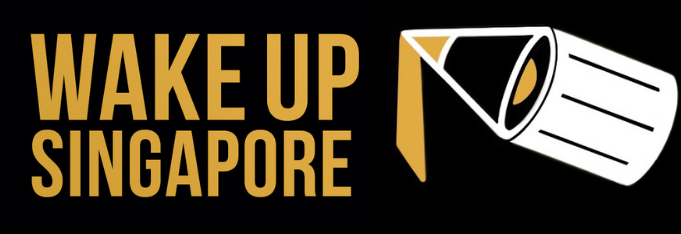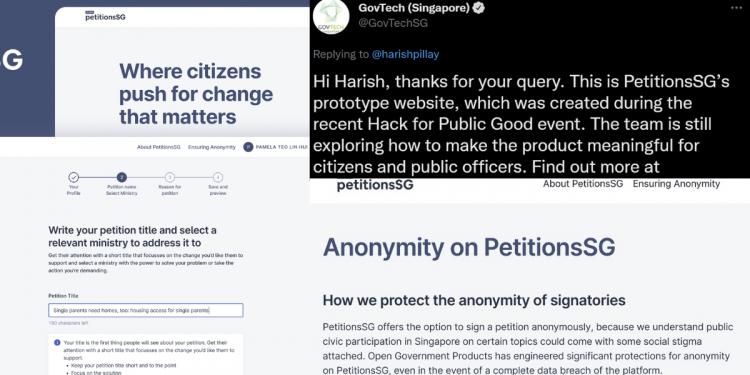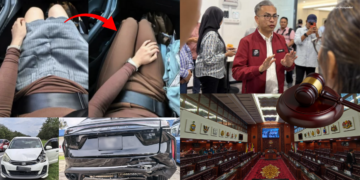The short life of PetitionsSG
PetitionsSG aimed to be “a government platform for citizens to push for change that matters, connecting the most important sentiments from the ground to ministries”.
On 5 May 2022, PetitionsSG was covered by the national broadsheet. The article stated that the platform was developed by Open Government Products, an experimental development team under GovTech.
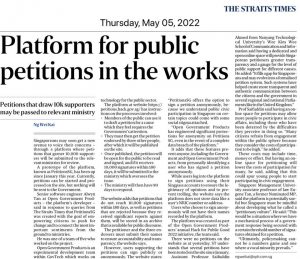
The article said that though the platform was in its prototype phase, it may soon provide “a new avenue [for Singaporeans] to voice their concerns.” The GovTech platform aimed to formalise the process of petitioning, where petitions would be submitted to respective ministries for review once they reached at least 10,000 signatures. The relevant Ministry would then have 90 days to respond to the petition.
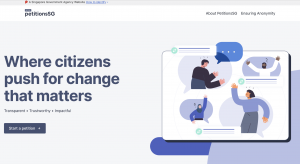
As seen in the picture above, members of the public who visited the website before 8.00pm on 5 May 2022 would have seen the front page emblazoned with the text, “Where citizens push for change that matters.”
Less than 12 hours later, the website was taken down.
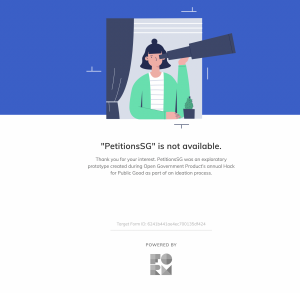
The Government later announced that there was no intention to fully launch this platform. As a GovTech spokesperson told Mothership, the platform “was built for internal user testing during the [GovTech] hackathon.” The GovTech representative also stated in no uncertain terms that:
The government actively seeks out views and concerns of citizens through various channels but we do not make decisions on the basis of petitions. The team has decided to no longer pursue the idea.
In the course of trawling, we came across this tweet dated 15 March 2022 from Gov.SG which stated that team was still “exploring how to make the product meaningful for citizens and public officers”.
Hi Harish, thanks for your query. This is PetitionsSG’s prototype website, which was created during the recent Hack for Public Good event. The team is still exploring how to make the product meaningful for citizens and public officers. Find out more at https://t.co/tr7ItcZ6Hk
— GovTech (Singapore) (@GovTechSG) March 15, 2022
As Kirsten Han, a journalist, asks:
It’s very curious that ST could have written such a report, with a quote from a member of the GovTech team working on PetitionSG and everything, for it have turned out to be such a nothingburger. Could there have been a U-turn somewhere?
Bertha Henson, a former SPH journalist, also wondered if someone (in GovTech) changed their mind or if ST “harden up the story too much”.

Are “official petition platforms” a good thing?
Before the website went down, there was a proliferation of debate on social media about the merits of such a platform. A good number of people were surprised to read that it would allow for anonymous signatures.
Some recalled the petition asking that Nagaenthran K. Dharmalingam, a Malaysian man on death row in Singapore, be granted clemency. This petition garnered over 106,000 signatures but received no formal responses from the government.

Similarly in 2020, at the height of the pandemic, a petition by activist Kokila Annamalai went up addressed to Josephine Teo, the then-Minister for Manpower, calling for prompt changes to the dismal and dangerous conditions that migrant workers lived under. The petition quickly reached 80,000 signatures but also received no response.
From these experiences, petitions on platforms like change.org can sometimes feel like shouting into the void. Nevertheless, it is probably a good thing that the Government scrapped the petition idea. Here’s why:
Concerns about Privacy
The platform would be developed by Open Government Products, an experimental development team under GovTech. The developer of PetitionsSG is therefore a part of the state, aiming to “empower” society, even assuring people of maximum confidentiality if they sign anonymously – but in order to sign the petition, even anonymously, you had to log-in via Singpass.
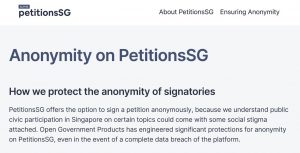
Despite abundant reassurances, a number still harboured concerns about privacy. Although Bertha Henson believes that “people should put their name down to what they say,” she “wondered” about anonymity in light of the fact that people need to use SingPass to sign it.
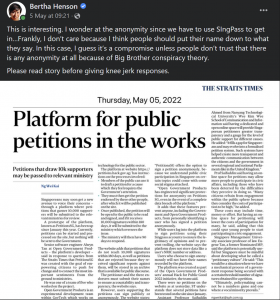
The TraceTogether Saga
Distrust over the state’s access even more data from citizens was laid bare when 50,000 people signed a petition in 2020 against wearable contact tracing devices.
To recapitulate, citizens were initially assured that TraceTogether data would only be used for contact tracing.
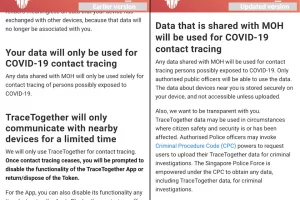
As Minister Vivian Balakrishnan said in June 2020:
“TraceTogether app, TraceTogether running on a device, and the data generated, is purely for contact-tracing. Period.”
A few months later, it was revealed in Parliament that TraceTogether data may in fact be used by the Singapore Police Force for purposes of investigations. The Minister then stood up in Parliament and apologised:
I take full responsibility for this mistake and I deeply regret the consternation, the anxiety that was caused by my mistake. … Perhaps I was so enamoured by what I thought was the ingenuity and brilliance of this that I got blindsided. But the damage was done. TraceTogether had already been rolled out, many Singaporeans put their trust in the government generally and in Minister Balakrishnan particularly, and then found out that their data could be used for at least one other purpose that they now knew about.
But the damage was done. TraceTogether had already been rolled out, many Singaporeans had put their trust in the government and then found out that their data could be used for at least one other purpose that they now knew about.
It is also worth highlighting, at this juncture, that public agencies are not governed by the Personal Data Protection Act. If PetitionsSG was rolled out and became the only petition site that the government took seriously, we would lose even more of our already precious little independent non-state spaces to voice our concerns – like change.org, google forms, etc.
Unofficial Petitions are as effective, if not even more, than “Official” Petitions
As we have explored in another article, no Government will readily admit that they were swayed by petitioners or public outroar. However, there may have been a few times way petitions may have helped to sway public opinion.
In the past the government has responded, though not directly, to issues that are addressed in popular petitions. What substantial difference would a formal response mean if these petitions were hosted on a government platform instead? If the petitions shifted to a government platform, who is to say that rules would not be changed in the future to increase the threshold for whether a Ministry had to reply?
Already, as Sean Lim points out, the short-lived guidelines relating to petitions that “receive significant reports against them” are troubling.
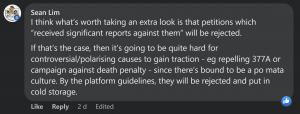
Further, how would such official platforms deal with petitions that, for example, call for the resignation of Government Ministers?
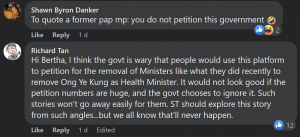
At the end of the day, the PAP government does still draw its power from the popular will of those it governs. If the tide turns against them on certain policies, they will be compelled to reply and possibly even U-turn regardless of the platform or medium.
This being the case, it seems safer to leave such a platform in independent hands. Why put the power, and the information, in the hands of an organ of the state.
You can still petition the Government at the Ballot Box
In Singapore’s climate, petitions lack teeth because there is largely nothing citizens can do if their demands are not met. One of the reasons for this is due to the lack of meaningful leverage among the people. What leverage do the people have, that the state doesn’t, which we are willing to leverage? One of the few things we have left are General Elections. There, we have the power to decide forcefully what we do and do not want.

The root cause of the lack of teeth in Singapore petitions is therefore the severe imbalance of power between the state and society. PetitionsSG does not address this. In fact, it may even increase the power of the state. It also strips away the ability for petition organisers to follow up with signatories to discuss possible escalation strategies.
One way that PetitionsSG could have remedied this issue is by introducing a mechanism to say that, upon reaching 10,000 signatures, petition organisers would be allowed to organise a town hall where representatives from the relevant ministries would have to attend.
The short-lived existence of PetitionsSG was merely an extension of what Garry Rodan, an academic, has called participation without democracy. It strengthens state-owned and controlled sites of participation (both online and off) at the expense of independent sites.
The people’s independent capacities to effect change are quickly co-opted and people power subsumes itself to state power. The more independent spaces we have, the better off we will be.
Since you have made it to the end of the article, follow Wake Up Singapore on Telegram!
